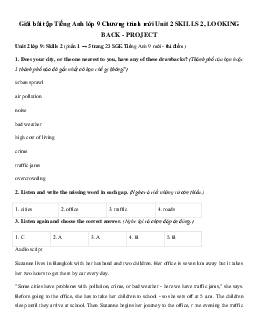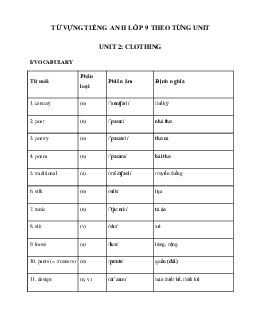







Preview text:
GIẢI SGK TIẾNG ANH LỚP 9 THEO TỪNG UNIT UNIT 2: CLOTHING
F. Write trang 18 19 SGK tiếng Anh 9 Unit 2
This is how to present one side of an argument. It is used to persuade
readers to believe or do something. An argument should have: Đây là cách
trình bày 1 ý kiến của một bên trong một bài tranh luận. Nó được sử dụng
để thuyết phục người đọc tin hay làm 1 điều gì đó. Một bài tranh luận nên có:
a. Read the topic and the Outline A. Then read the passage. (Hãy đ ọc chủ
đề và dàn bài A. Sau đó đọc đoạn văn.)
I think it is necessary for secondary school students to wear uniforms when they are at
school. (Tôi nghĩ học sinh trung học cần thiết phải mặc đồng phục khi chúng còn học tại trường)
Firstly, wearing uniforms encourages students to be proud of being students of their school
because they are wearing the uniforms with labels bearing their schools name. (Trước hết,
việc mặc đồng phục khuyến khích học sinh tự hào về trường học của mình vì chúng mặc
đồng phục có phù hiệu mang tên trường của mình)
Secondly, wearing uniform helps students feel equal in many ways, whether they are rich or
poor. (Kế đến, mặc đồng phục giúp học sinh cảm thấy bình đẳng trong nhiều phương diện dù cho chúng giàu hay nghèo)
Finally, wearing uniform is practical. You don't have to think of what to wear every day.
(Cuối cùng, việc mặc đồng phục rất thiết thực. Bạn không cần phải nghĩ xem sẽ phải mặc đồ gì mỗi ngày)
Therefore, students in secondary schools should wear uniforms.
b. Now write a paragraph of 100 - 150 words. But this time you support
the argument that secondary school students should wear casual clothes.
Outline B may help you. (Bây giờ hãy viết một đoạn văn khoảng 100 - 150
từ. Nhưng lần này em hãy bênh v ực ý tranh luận rằng học sinh trung học
nên mặc y phục thông thường. Dàn bài B có thể giúp em).
My opinion is that high school students should wear casual clothes. (Theo ý kiến của tôi, học
sinh trung học nên mặc thường phục)
Firstly, casual clothes make students feel comfortable because they don't feel constrained to
wear uniforms that they don't like. (Trước hết, thường phục làm cho học sinh cảm thấy thoải
mái vì họ không cảm thấy miễn cưỡng khi mặc đồng phục mà chúng không thích)
Secondly, wearing casual clothes gives students freedom of choice. They have rights to
choose sizes, colors and fashion that they love. (Tiếp đến, việc mặc thường phục đem lại cho
học sinh sự tự do chọn lựa. Chúng có quyền chọn lựa kích cỡ, màu sắc và kiểu dáng mà chúng thích)
Finally, casual clothes make school more colorful and lively. (Cuối cùng, thường phục làm
cho trường học có nhiều màu sắc và sống động hơn)
In conclusion, students, particularly high school students should wear casual clothes.
Wearing casual clothes is convenient, comfortable and fun.
G. Language Focus trang 19 20 21 SGK tiếng Anh 9 Unit 2 The present perfect The passive (review)
1. Work with a partner. Read the dialogue. (Th ực tập với bạn. Đọc bài đối thoại)
Nga: Come and see my photo album. Đến đây xem anbom hình của mình nè)
Mi: Lovely! Who's this girl? (Dễ thương quá! Cô gái này là ai?
Nga: Ah! It's Lan, my old friend. (À, đó là Lan, bạn cũ của mình)
Mi: How long have you known her? (Bạn biết cô ấy bao lâu rồi?)
Nga: I've known her for six years. (Mình biết cô ấy 6 năm rồi)
Mỉ: Have you seen her recently? (Gần đây bạn có gặp cô ấy không?)
Nga: No, I haven't seen her since 2003. (Không, mình không gặp cô ấy từ năm 2003)
She has moved to Ho Chi Minh City with her family. (Cô ấy đã dọn đến TPHCM vđi gia đình)
Now use the information in the table to make similar dialogues. (Đây gi ờ
hãy sử dụng thông tin trong báng để làm những bài đối thoại tương tự) a) Lan - old friend 2003 six years b) Quang - brothers friend January seven months c) Hoa - new friend Monday three weeks Gợi ý b)
Nga: Come and see my photo album. (Đến đây xem tập hình của mình nè)
Mi: Lovely! Who;s this boy? (Dễ thương quá! Anh chàng này là ai?)
Nga: Ah! It's Quang, my brothers friend. (À, đó là Quang, bạn của anh mình) Mi: How long
have you known him? (Bạn biết anh ấy bao lâu rồi?)
Nga: I've known him for seven months. (Mình biết anh ấy được 7 tháng rồi)
Mi: Have you seen him recently? (Gần đây bạn có gặp anh ấy không?)
Nga: No, I haven't seen him since January. (Không, mình không gặp anh ấy từ tháng giêng)
He has moved to Ho Chi Minh City with his family. (Anh ấy đã dọn đến TPHCM vđi gia đinh) c)
Nga: Come and see my photo album. (Đến đây xem tập hình của minh nè)
Mi: Lovely! Who's this girl? (Dễ thương quá! Cô gái này là ai?)
Nga: Ah! It's Hoa, my new friend. (À, đó là Hoa, bạn mới của minh)
Mi: How long have you known her? (Bạn biết cô ấy bao lâu rồi?)
Nga: l've known her for three weeks. (Minh biết cô ấy được 3 tuần rồi)
Mi: Have you seen her recently? (Gần đây bạn có gặp cô ấy không?)
Nga: No, I haver/t seen her since Monday. (Không, mình không gặp cô ấy từ thứ hai)
She has moved to Ho Chi Minh City with her family. (Cô ấy đã dọn đến TPHCM với gia đình)
Work with a partner. Imagine you and your partner are visiting Ho Chi
Minh City. Ask and answer questions about the things you have done. Use
the present perfect tense of the verbs in the box. Thực tập với bạn cùng học.
Tưởng tựơng em và bạn đang viếng thăm TPHCM. Hỏi và trả lời về những điều các em đã
làm. Dùng thì hiện tại hoàn thành của những động từ trong khung.
a) Have you visited Reunification Palace yet? -> No, I haven't visited it yet.
b) Have you visited the Zoo and Botanical Gardens yet? -» No, I haven't
c) Have you gone to Dam Sen Amusement Park yet? -» No, I haven't.
d) Have you eaten vegetarian food yet? -» No, I haven't.
e) Have you eaten French food yet? -» Yes, I have already eaten it.
f) Have you eaten Chinese food yet? —» Yes, I have already eaten it.
3. Work with a partner. Ask and answer questions about each of the item s in the box. comic computer supermarket volleyball Singapore movies elephant Hue durian
a. Have you ever read a comic? --> Yes, I have.
When did you last read one? --> This morning.
b. Have you ever been to Singapore? -> No, I haven't.
c. Have you ever played volleyball? -> No, I haven't.
d. Have you ever seen an elephant? -> Yes, I have.
Where did you last see one? -> In the zoo and Botanical Garden.
e. Have you ever been to Hue? -> No, I haven't.
f. Have you ever used computer?
When did you last use one? -> Yesterday,
g. Have you ever gone to the supermarket? -> Yes, I have.
When did you last go to one? -> Last week.
h. Have you ever seen movies? -> Yes, I have.
When did you last see one? -> Last month.
i. Have you ever eaten durian? -> Yes, I have.
When did you last eat one? -> Last year.
4) Read the first sentence and the complete the second sentence with the
same meaning. Use the passive form. (Đọc câu đầu tiên và hoàn thành câu
thứ hai với cùng ý nghĩa. Dùng d ạng bị động)
Ex: They sell jeans all over the world.
Jeans are sold all over the world.
a) They made jeans cloth from cotton in the 18th century.
(Vào thế kỷ 18 họ đã làm ra jeans từ vải sợi bông.)
Jean cloth..................................................................
b) They grow rice in tropical countries.
(Người ta trồng lúa ở những nước nhiệt đới.)
Rice..................................................................
c) They will produce five milllion bottles of champagne in France next year.
(Năm tới họ sẽ sản xuất 5 triệu chai rượu sâm panh ở Pháp.)
Five million bottles of champagne...................................
d) They have just introduced a new style of jeans in the USA.
(Họ vừa mới tung ra một kiểu jeans mới ở Mỹ.)
A new style of jeans..........................................
e) They have built two depatment stores this year.
(Năm nay họ đã xây hai cửa hàng bách hóa ở đây.)
Two departments stores...................................... Gợi ý đáp án
a) Jean cloth was made from cotton in tho 18th century.
(Vải jeans được làm t ừ vải sợ bông vào thế kỷ 18.)
b) Rice is grown in tropical countries.
(Lúa được trồng ở những nước nhiệt đới.)
c) Five million bottles of champagne will be produced in France next year.
(5 triệu chai rượu sâm panh ở Pháp sẽ được sản xuất ở Pháp vào năm tới.)
d) A new style of jeans has just been introduced in the USA.
(Một kiểu giới mới vừa đư ợc tung ra ở Mỹ.)
e) Two departments stores have been built this year.
(Hai cửa hàng bách hóa đư ợc xây ở đây trong năm nay.)
5) Change the sentences from the active into the passive. (Đ ổi những câu
sau từ chủ động sang b ị động) a. We can solve the problem.
-> The problem can be solved.
b. People should stop experiments on animals.
-> Experiments on animals should be stopped.
c. We might Find life on another planet.
-> Life might be found on another planet.
d. We have to improve all the schools in the city -» All the schools in the city have to be improved.
e. They are going to build a new bridge in the area.
-> A new bridge is going to be built in the area.




